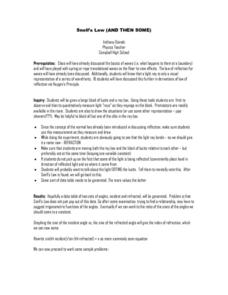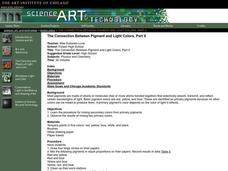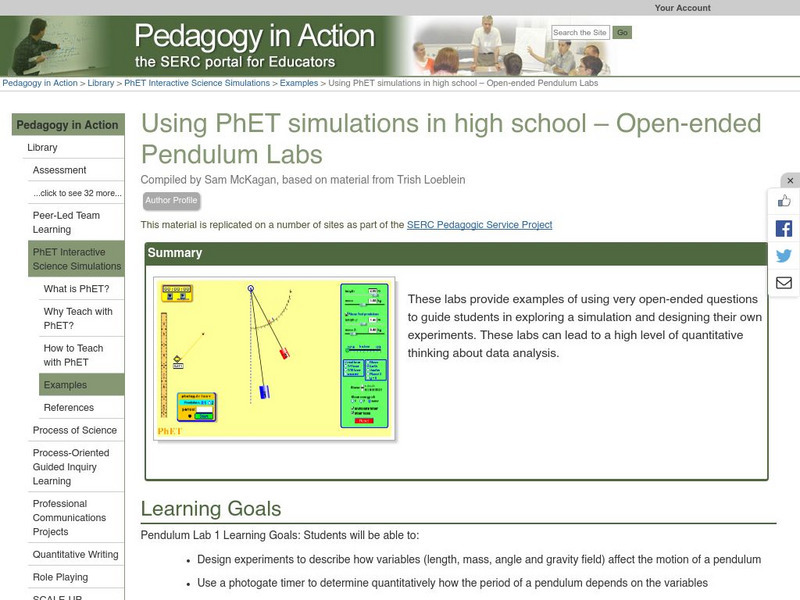University of Colorado
The Jovian Basketball Hoop
Can you listen to Jupiter on a simple radio? Turns out the answer is yes! The resource instructs scholars to build a simple radio to pick up the radio waves created when the charged particles from the sun hit Jupiter's magnetic...
Curated OER
Shrinky Dinks® Palettes
Here is a fun and clever lesson for teaching physics classes how to calculate wavelength if given the energy and frequency data. On a worksheet, they compute wavelengths using a table of information that you provide. On a paper palette,...
Colorado State University
How Can I Turn a Solar Oven into a Refrigerator?
Whether you want to heat things up in science class or cool things down a bit, an intriguing lab's got you covered! Science scholars explore the principles of thermodynamics using a solar oven, then change the conditions to turn their...
Curated OER
Long Rope Jumping
Learners participate in long rope jumping. In this physical education lesson plan, students use four cones and a long rope to complete several activities. One learners has the role of a "turner" and their partner is the "jumper." Each...
Exploratorium
Hot Spot
Not only does a concave mirror focus light waves, it can also concentrate infrared radiation into a hot spot. If you have a small electric heater and such a mirror, demonstrate this for your physical science class.
Curated OER
Seeing Interference Fringes with a Telescope
Students construct an interferometer using a simple telescope. In this physics lesson, students explain how light waves create the fringe patterns. They observe patterns made by different objects in the sky and compare them.
Channel Islands Film
Once Upon A Time (Saxipak’a): Lesson Plan 1
As part of a study of the history of the Chumash on California's Channel Island chain, class members view the documentary Once Upon a Time, respond to discussion questions, and create a timeline for the different waves of migration.
National Nanotechnology Infrastructure Network
Jell-O® Waveguide and Power Loss
Jell-O® can help model the transmission of light through fiber optic cables. Young scientists use the jiggly dessert to make a waveguide to transmit a laser beam from one point to another. Their models help them learn the function...
Curated OER
The Space Cadet's Laboratory: Using Electromagnetic Energy to Study Astronomy
Students build their own spectrophotometer to study light. In this physics lesson, students explain the dual nature of light. They calculate the angle of incidence and refraction using Snell's law equation.
Curated OER
The AM Radio: An Exploration of Communication Using Radio Waves
Students examine the components that are used to make a primitive AM radio. In circuit and radio construction students often are asked to assemble parts are or what function they perform. They examine each main component on an individual...
Curated OER
The Sine Function
Students explore the concept of the sine function. For this sine function lesson, students use a plexiglass sine wave generator to visualize the sine function. Students use a computer program/calculator to adjust aspects of the sine...
Curated OER
Tune Up Your Ears!
Students discuss meaning of pitch, listen for different sounds in classroom, hallway, and outdoors, and listen to sounds played on piano and on computer to determine high or low pitch.
Curated OER
CO2 and You
Students study the scientific evidence about carbon dioxide emissions. They learn to calculate the amount of energy used by different appliances. They complete a worksheet which analyzes the amount of energy that their home uses.
Curated OER
Understanding the Cosmic Microwave Background (CMB)
How did our universe really begin? Explore the Science Big Bang Theory and Cosmic Microwave Background (CMB) with this multiple activity-based lesson that demonstrates that the increase of density due to the decrease of temperatures,...
National Nanotechnology Infrastructure Network
Powers of Ten with the Blue Morpho Butterfly
Explore the powers of ten while examining a Blue Morpho butterfly wing. Learners discover there is a lot more than meets the eye when one looks close enough.
Curated OER
Snell's Law (And Then Some)
Students conduct an experiment to test Snell's Law using a block of lucite and a ray box. They measure the light rays as they impinge upon the block. Students are also asked to draw the situation of the lab or create a model of the...
Curated OER
The Connection Between Pigment and Light Colors
Students learn the procedure for mixing secondary colors from primary pigments and observe the results of mixing two primary colors.
Curated OER
Vibration and Pitch
Fifth graders investigate the relation between vibrations and pitch. They observe and discuss an experiment involving a bicycle and a piece of cardboard in the spokes, listen to a comb with cardboard, and listen to various sounds and...
CK-12 Foundation
Ck 12: Interactive Physics for High School
This digital textbook covers core physics concepts and includes interactive features, real world examples, videos, and study guides.
Science Education Resource Center at Carleton College
Serc: Using Ph Et Simulations in High School Open Ended Pendulum Labs
These labs provide examples of using very open-ended questions to guide students in exploring a simulation and designing their own experiments. These labs can lead to a high level of quantitative thinking about data analysis.
Massachusetts Institute of Technology
Mit: Open Course Ware: Physics Exam Prep: Waves
Students explore traveling waves and wave propagation. The resource links to courses with videos, online textbook materials, simulations, and practice problems.
Physics Classroom
The Physics Classroom: The Doppler Effect and Shock Waves
This high school physics lesson focuses on the application of the Doppler effect to sound. Discusses what the Doppler effect is, offers examples of its occurrence, and explains what shock waves and sonic boom are.
Physics Classroom
The Physics Classroom: Two Point Source Interference
This lesson from the Glenbrook South High School discusses two-point source interference. It gives detail on the difference between constructive and destructive interference, what a two-point source interference is and what happens when...
Other
Physics of Sound/image Analysis of Sound Pressure
A discussion on how to locate the sound image based upon the incident and reflected pulse of sound heard at a given location. For those looking for a challenge, follow the links to view derivations of wave equations for sound (uses...






















